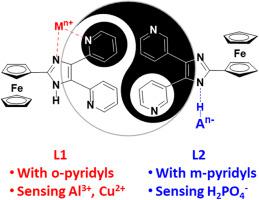Tetrahedron ( IF 2.1 ) Pub Date : 2021-09-13 , DOI: 10.1016/j.tet.2021.132434 Jiali Sun 1 , Quanling Suo 1 , Jingna Hou 1 , Teng Ma 1 , Xuechuan Gao 1 , Li Lv 1 , Yuanyuan Gao 1 , Huijie Jia 1 , Yaqi Wang 1

|
Two 2-ferrocenylimidazoles decorated with two pyridyl arms, 2-ferrocenyl-4,5-di(2-pyridyl)-1H-imidazole (L1) and 2-ferrocenyl-4,5-di(3-pyridyl)-1H-imidazole (L2), have been synthesized as potential multichannel ditopic receptors for cations and anions, owing to the presence of redox, chromogenic and fluorescent groups at the imidazole core. The structures of L1 and its Ag(I) complex (I) [L12·Ag2·(NO3)2] were further confirmed by X-ray crystal analysis. The most salient features derived from sensing studies are that L1 behaves as a highly selective fluorescent “turn-on” receptor for Al3+ and Cu2+ cations, whereas L2 acts as a dual fluorescent “turn-on” and redox selective receptor for H2PO4− anions. This significant change in fluorescent sensing selectivity is due to the change in the relative position of N atoms in the pyridyl groups. Furthermore, the resulting complexes of L1-Al3+ and L1-Cu2+ systems are able to detect Br− and I− by color changes. The sensing mechanism and binding mode of these two receptors were confirmed by titration spectra and ESI-MS. Finally, living cell imaging experiments demonstrated the value of L1 in the fluorescent visualization of Al3+ ions in biological systems.
中文翻译:

基于 2-二茂铁基咪唑的 Al3+、Cu2+ 和 H2PO4− 离子多响应受体:结构修饰对离子传感性能的影响
两个 2-ferrocenylimidazoles 装饰有两个吡啶基臂,2-ferrocenyl-4,5-di(2-pyridyl)-1H-imidazole (L1)和 2-ferrocenyl-4,5-di(3-pyridyl)-1H-imidazole ( L2 ),由于咪唑核心处存在氧化还原、显色和荧光基团,已被合成为阳离子和阴离子的潜在多通道双位受体。的结构L1和其银(I)络合物(我)L1 2 ·银2 ·(NO 3)2 ]通过X射线晶体分析进一步证实。来自传感研究的最显着特征是L1表现为 Al 的高度选择性荧光“开启”受体3+和Cu 2+阳离子,而L2充当H 2 PO 4 -阴离子的双重荧光“开启”和氧化还原选择性受体。荧光传感选择性的这种显着变化是由于吡啶基团中 N 原子的相对位置发生了变化。此外,L1 -Al 3+和L1 -Cu 2+系统的所得配合物能够通过颜色变化检测Br -和I -。通过滴定光谱和ESI-MS证实了这两种受体的传感机制和结合模式。最后,活细胞成像实验证明了L1在生物系统中 Al 3+离子的荧光可视化中。


























 京公网安备 11010802027423号
京公网安备 11010802027423号